There exist two distinct strata in the watch customization world. I explored one in an earlier article on watch customization (see Watch Customization: Give People The Watch They Want), explaining how brands seek to differentiate themselves in meaningful ways by customizing watches for their clients.
However, to do so profitably there has to be a menu of acceptable custom changes to a regular production piece. Armin Strom, Ochs und Junior, and Christiaan van der Klaauw among others have online customizer tools for their clients to “design” their own watches.
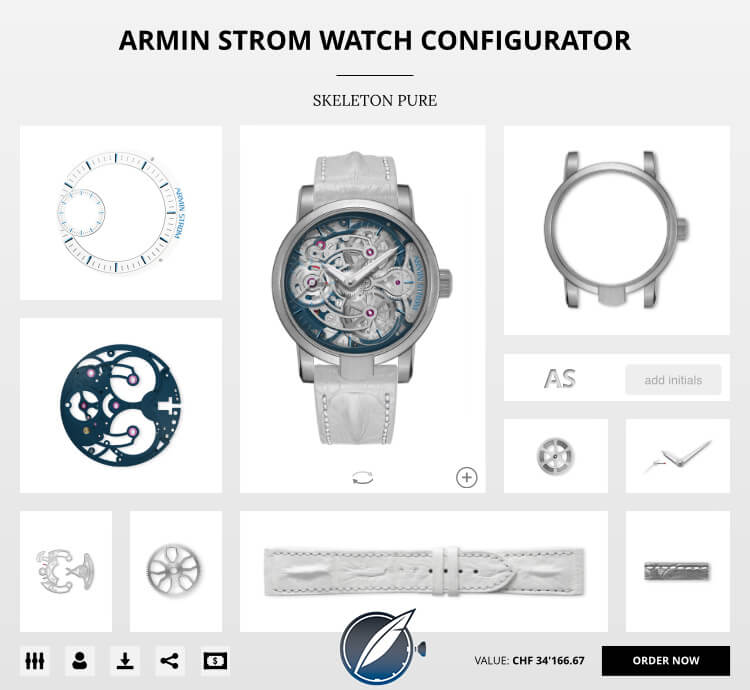
A customized Armin Strom Skeleton Pure in the brand’s configurator
A second stratus in watch customization is found at the higher end – pieces in the mid-five and -six figure range and soaring from there.
Clients at this level often want a watch made exclusively for them. These watches become possessions that raise the cache as only a unique piece can.
For such collectors, it is not sufficient to just have a modified timepiece; it must feel produced to their unique specifications.
Why a customized piece?
Romain Gauthier was kind enough to carve out some time to discuss his take on customization. Speaking with him conveys his total enthusiasm for watchmaking.
Gauthier’s ultra-exclusive brand began in 2005 with prices for its production pieces starting in the mid-five figures. Customized Romain Gauthier timepieces have gone up to prices of $300,000.
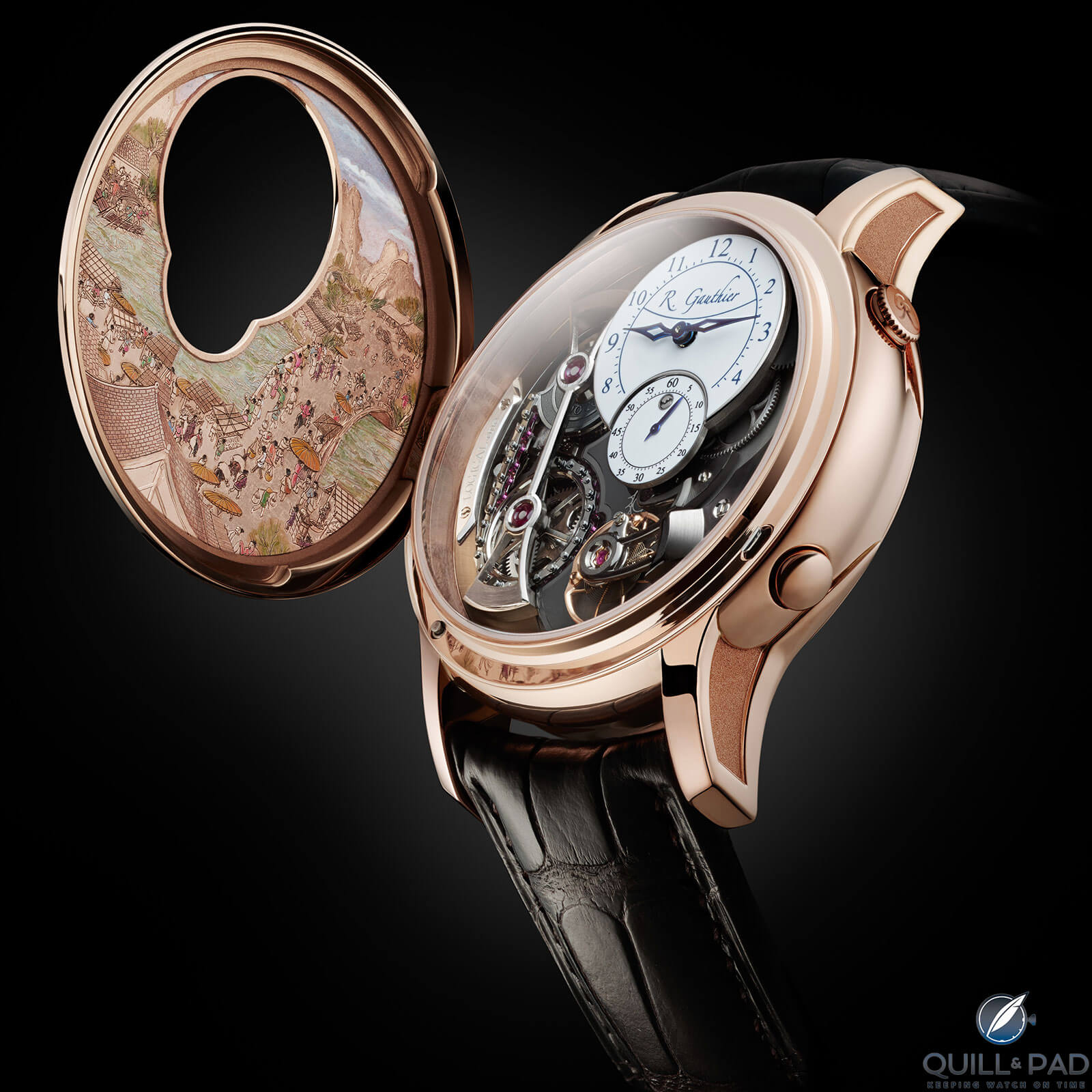
Romain Gauthier Logical One Empires Secret Song Dynasty
Gauthier believes that people should have their fingerprints on their watch design. Yet he didn’t actively accept custom commissions until well after the firm’s beginning.
Even with the exclusivity of this brand, which only produces about 60 pieces annually, a design that’s generally available to anyone with capacity to pay is of lesser interest to some. It seems the conventional thinking among those in the market for a customized piece is: if another person can have the same watch, then what’s the point? Many of Gauthier’s clients have specific ideas about adding their own unique twists.
Christiaan van der Klaauw’s Daniël Reintjes also has an opinion as to why his customers demand unique, bespoke pieces. Predominately crafting astronomical complication timepieces, Christiaan van der Klaauw has its own signature design. And each piece is rare.
However, he says, bespoke pieces, “Are unique, intelligent, and with complications that are not often seen. For the aficionado, the most important thing is how incredibly clever these complications are and, equally important, how beautiful. CVDK’s inspired designs and classic watchmaking combine to create works of eternal beauty.”
Pascal Raffy, CEO and owner of Bovet, has another take on his clients’ desire to customize their watches: “Our watchmaking conveys emotion rather than being an object of social recognition. Whether a craftsman has spent hundreds of hours peering into a microscope while hand-painting the portrait of a customer’s loved one on a dial or engraving the case with a decorative pattern, it conveys the emotion that distinguishes a luxury object from one that is mass-produced.”
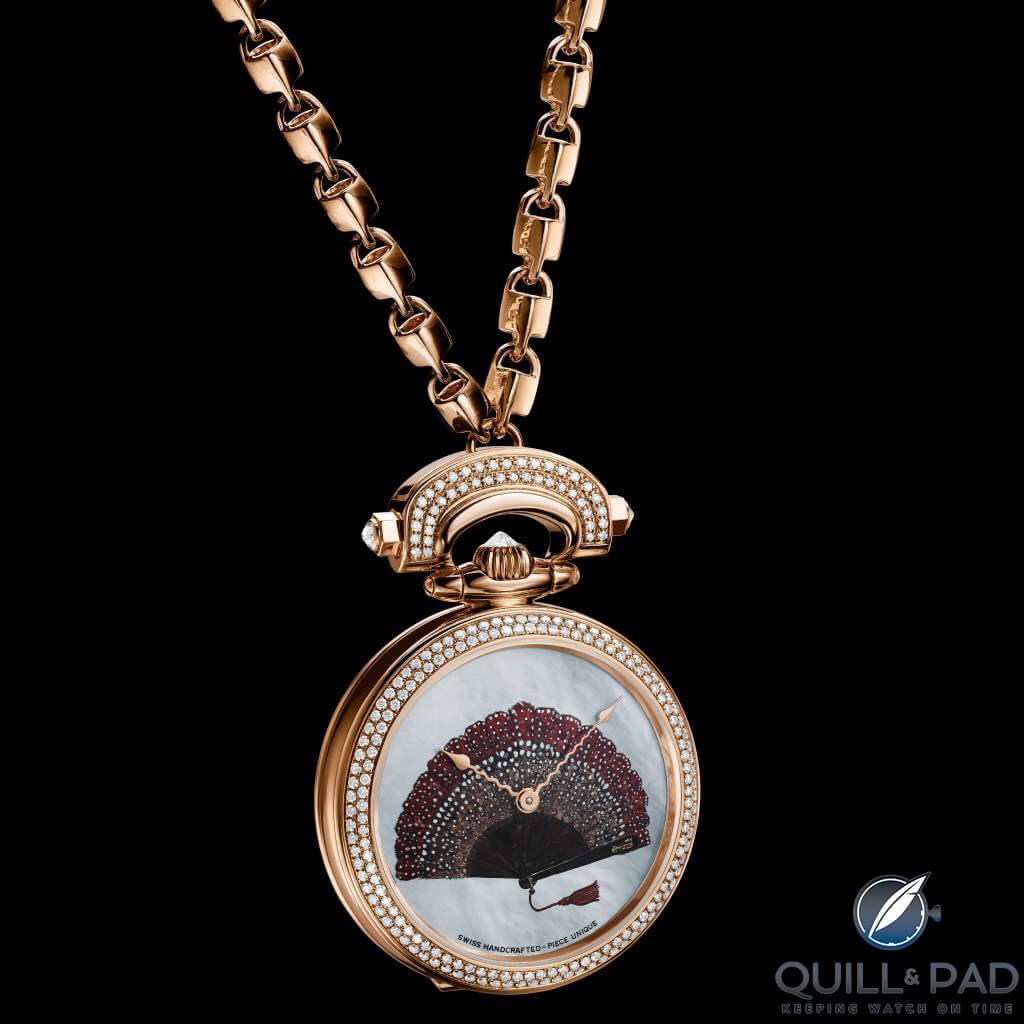
Bovet 1822 Amadeo Fleurier 39 Fan pendant
Limitations on customization
At the end of the day, even the ultra-high-end brands must face the profit imperative. That means enforcing limits – even [gasp] on customization. Romain Gauthier, for example, limits his customization mostly to dial colors, enamel work on dials, finishing options, hands, the addition of precious stones, and micro engraving.
Gauthier requires that each customization commission retain the brand’s “DNA.”
I asked what that meant. To Gauthier, it’s finding the right balance between function, reliability, and aesthetics. Absent that balance and consistency with the rest of the brand, he simply won’t accept the commission. He is a man comfortable in his own skin and satisfied with his place in the watch world.
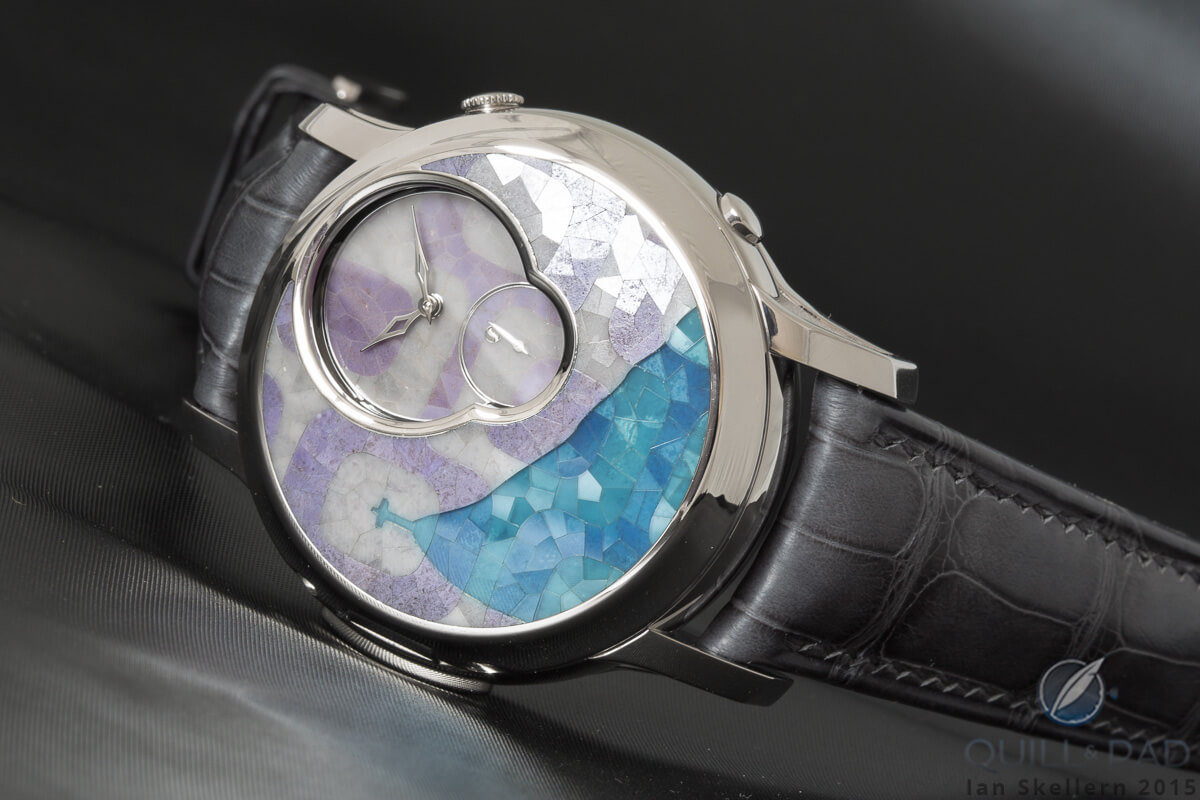
Roman Gauthier Logical One Secret Kakau Höfke
However, there’s Gauthier the artist/engineer and there’s Gauthier the businessman. It seems that he’d love to build a custom piece from the ground up. But with a business to run, that’s not possible. Still, the customization options he does offer truly create some unique pieces.
Because these changes can often require a different supply chain, Gauthier adds $20,000 to the base price of the watch to start customization and it may well go up from there.
Bovet added a number of creative, technical, and manufacturing innovations as resources for custom work in the modern era. It is one of the go-to brands for those interested in custom portraiture on the watch dial or case.
Bovet has built solid relationships with miniature painter André Martinez and enameler Ilgiz Fazulzyanov. The variety of dials and cases in the brand’s collection lends itself to different applications of the art form.
Bovet also became known for its 2017 introduction of miniature painting techniques combining traditional artisanal methods with luminescent material. Seeing the hand-painted theme at night reveals every detail from a completely new perspective.
The company used this technique on the three-dimensional globe of its award-winning Récital 22 Grand Récital. The luminescent painted details of the globe takes more than two weeks to produce, while the detailed engraving on the moon orbiting it accurately recreates the moon’s topography.
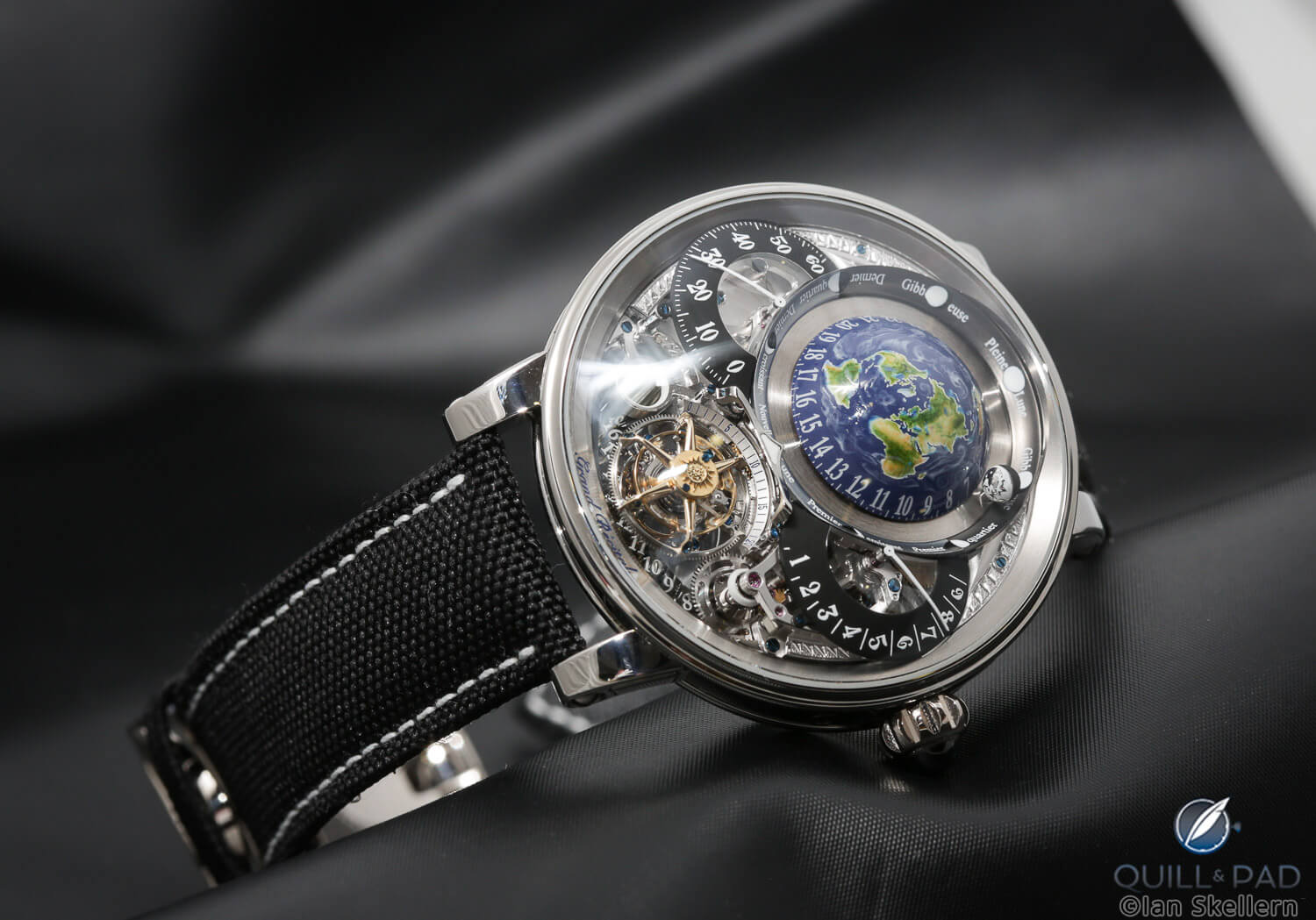
Bovet Récital 22 Grand Récital
There are just 60 examples of the Récital 22 Grand Récital, which won the Aiguille d’Or of the Grand Prix d’Horlogerie de Genève (GPHG) last November. The version in pink gold is priced at $469,800, while a platinum edition costs $502,200.
For that kind of money Raffy offers clients the ability to choose the orientation of the painted world map so that their chosen locations would be positioned on the earth-sun axis when the timepiece displays midday. This customization also makes it possible to determine where it is currently nighttime in the world thanks to the black and white coloring of the ring surrounding the earth.
About 30 percent of the timepieces Bovet produces are customized or unique. The company integrates these projects into its regular manufacturing workflow. That’s just one way that, despite their complexity, Bovet manages to complete custom projects in a surprisingly short time frame.
What if there were no limitations?
Christiaan van der Klaauw has a different take on imposing limitations on customization: none. The eponymous watchmaker started in 1974 making Frisian clocks. Even then, most were custom commissions.
Van der Klaauw began making wristwatches in 1996, each of which was a bespoke commission order from the customer. So customization is nothing new to this venerable boutique brand, which was taken over by Daniël and Maria Reintjes in 2009.
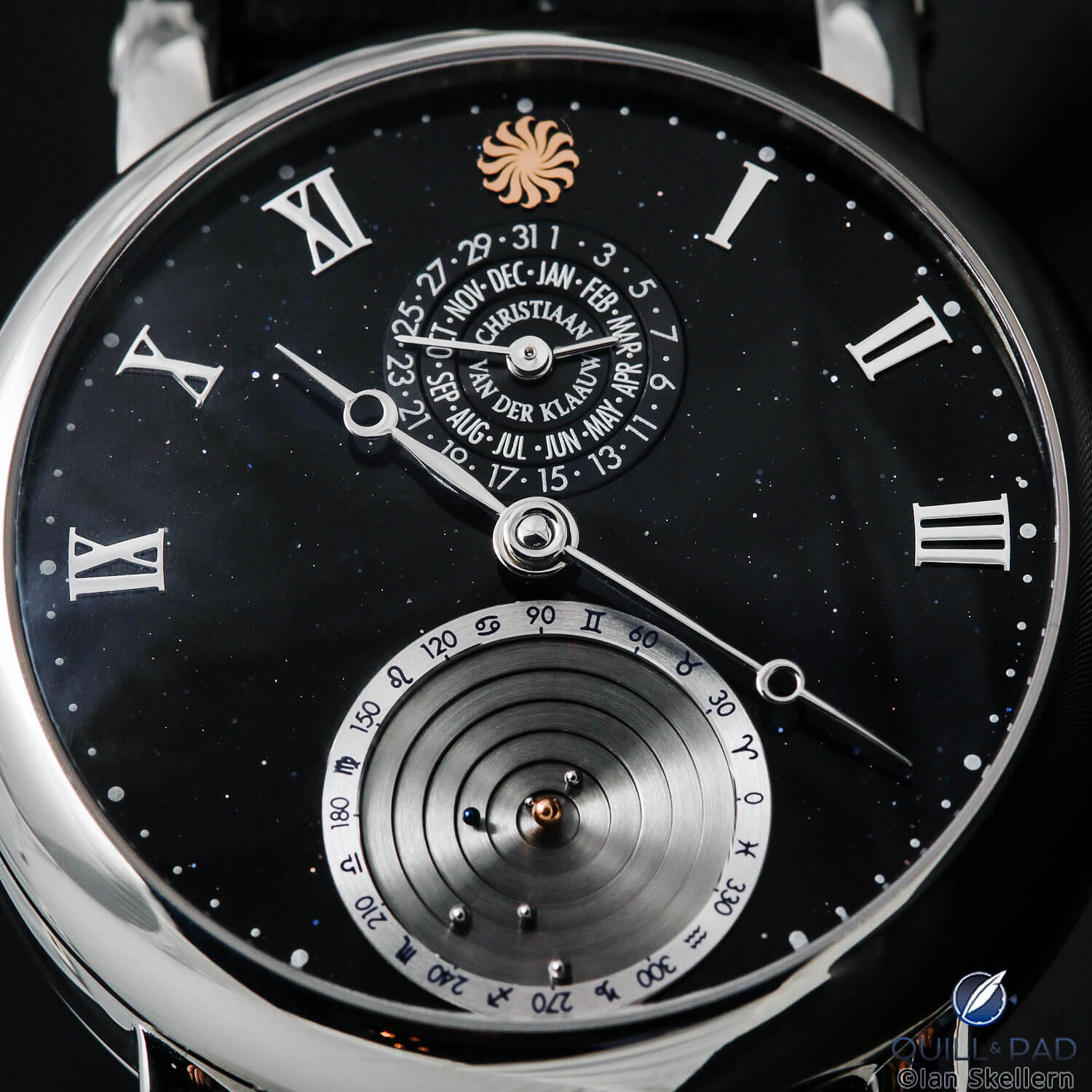
Christiaan van der Klaauw Planetarium with an exceedingly rare black aventurine dial
Christiaan van der Klaauw’s is the only atelier in the world completely devoted to the design and the production of handmade astronomical watches. If that is your interest, then this is your brand. Practically every watch has one or more astronomical complications.
But wait. There’s more. Christiaan van der Klaauw also has a department dedicated to customization called “the Collection of the Atelier.” For those wishing for a completely unique astronomical watch, the “Atelier” turns dreams into reality, and there are few limitations placed on commissions.
Most customizations deal with materials, complications, dials, rotors, and finishes. Pretty much anything the client wants, Christiaan van der Klaauw’s “Atelier” can do. And each piece produced in this department is one of a kind.
From the Christiaan van der Klaauw “Atelier” came the famous Van Cleef & Arpels Midnight Planetarium and the Lady Arpels Planetarium (also a winner at the Grand Prix d’Horlogerie de Genève).
Christiaan van der Klaauw modified the Midnight Planetarium piece it created for Van Cleef & Arpels and dressed it up with diamonds to make the Lady Arpels Planetarium. While Mercury, Venus, and Earth rotate around the sun at their actual speeds, the diamond moon completes its orbit in 29.53 days. Truly, this is a custom piece if ever there was one.
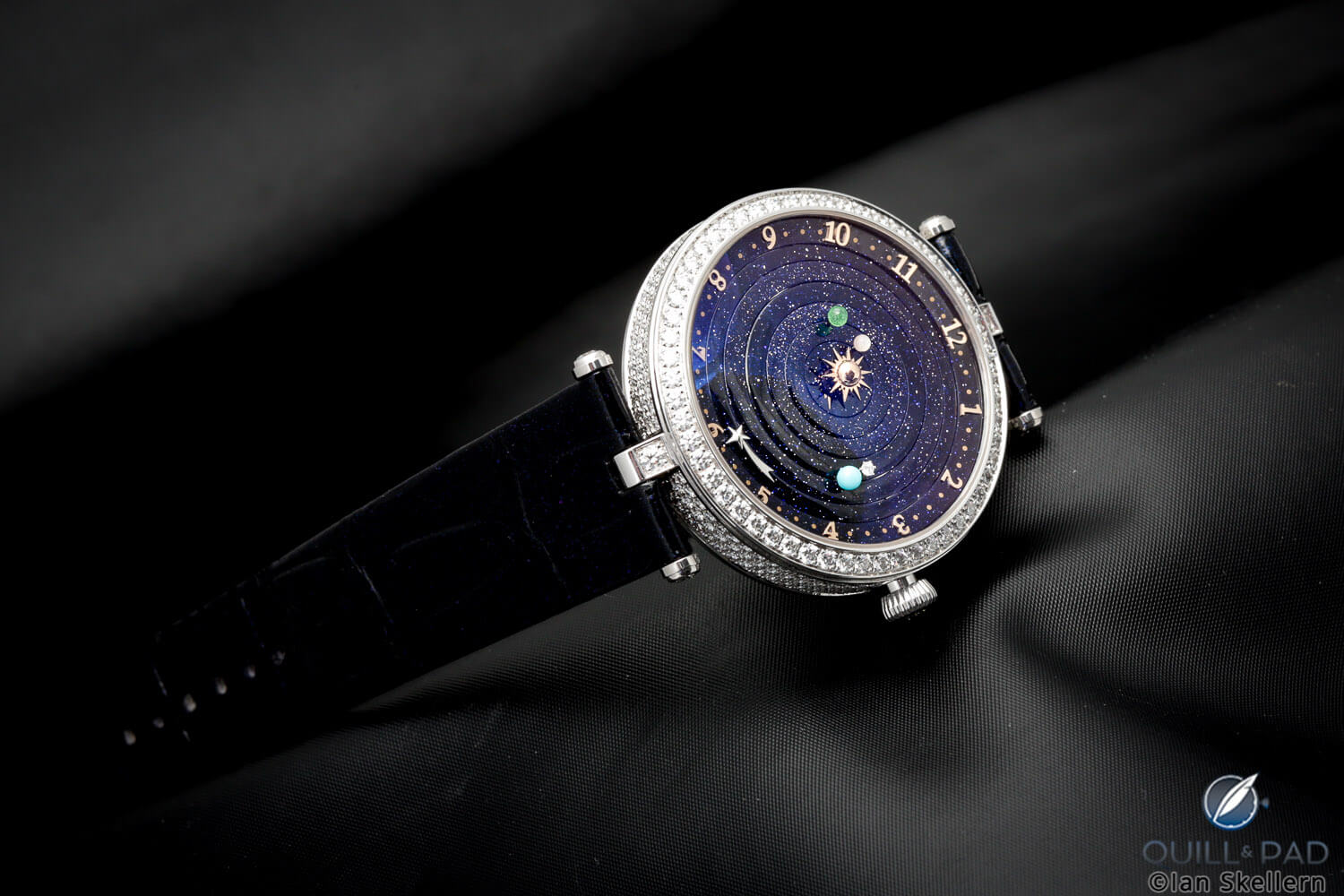
Van Cleef & Arpels Lady Planétarium
Christiaan van der Klaauw ’s customization atelier also produces very small series of pieces, with the outstanding Real Moon Stella Nebula being one such custom series of just five pieces. These feature the rare gem Ammolite originating from prehistoric marine fossils dating back 71 million years. This stone insert produces a phenomenally colorful dial similar to a deep-space photograph from the Hubble telescope.
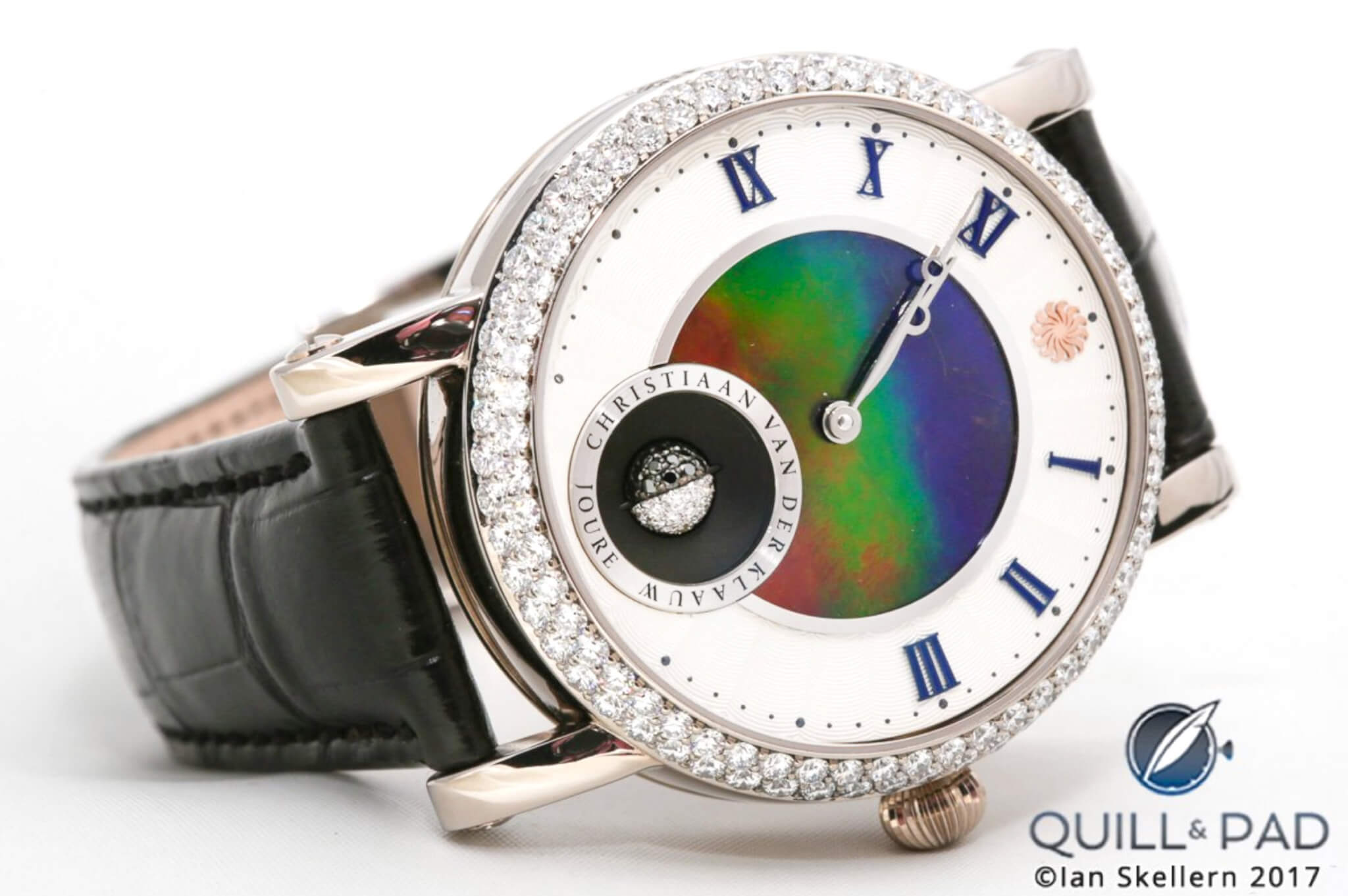
Christiaan van der Klaauw Real Moon Stella Nebula with Ammolite dial
For Bovet, there are also very few customization restrictions. Should a client’s idea impact the timekeeping or reliability of the timepiece, Bovet’s designers and engineers may discuss alternatives with the customer to achieve the desired results while maintaining the company’s high quality standards.
Additionally, some ideas for personalization may involve technical changes to the movement. Raffy says they always consider such requests and do them if at all possible. He adds that usually the only limits for personalization are those the customers set for themselves.
What does it take?
None of the three brands I spoke with cited revenue as a primary criterion for accepting a custom commission. These are artists, after all.
For Romain Gauthier, who is doing the asking for a custom piece makes no difference. He limits his custom work to just one of the three collections he makes, the Exception collection.
He analyzes the customer’s ideas and tries to find the balance between function, reliability, and aesthetics while looking for a solid marriage between performance and aesthetics. If the design agreed on maintains the Romain Gauthier voice in terms of engineering and finishing, then he’ll likely take the commission as long as the shop has the time and resources needed to perform the project.
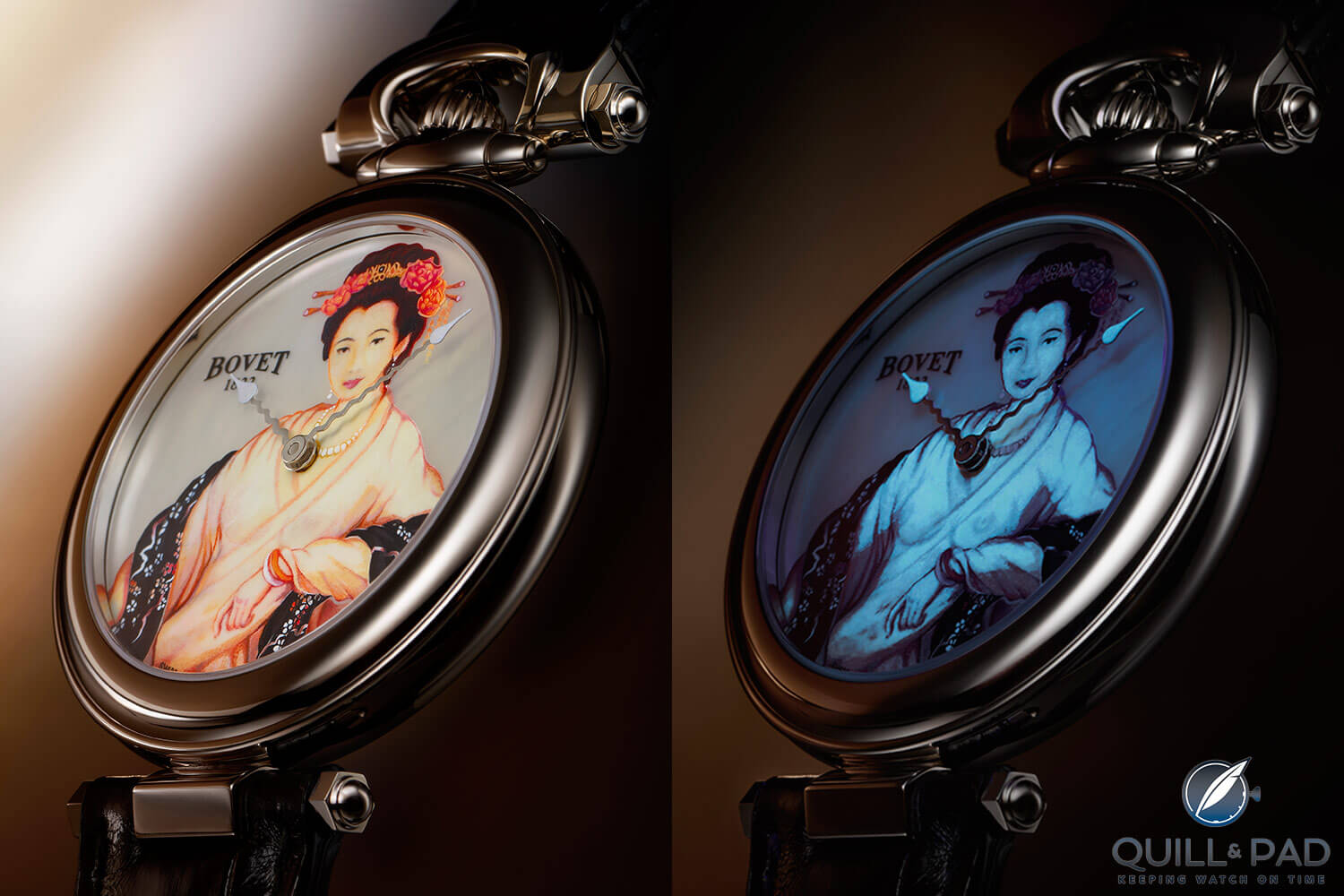
Bovet Secret Beauty for Only Watch: the ultimate customization project featuring luminous miniature painting
For Bovet, cost of the project is of lesser importance when considering a commission. The identity of the customer is also not a consideration. The main driver seems to be how interesting and/or challenging it is and what the final result will look like.
Who commissions customization?
When I first asked this question, I imagined those who demanded bespoke watches would be the luminaries of this world: royalty, sports figures, politicians, those seen on the silver screen or perhaps singing to packed stadiums. In other words, those with the disposable funds to get exactly what they want.
I was wrong. Romain Gauthier says about 80 percent of his customization clients are entrepreneurs as well as watch collectors. Most are people you’ve never heard of.
Pascal Raffy is very protective of Bovet’s customization clients’ privacy and couldn’t even discuss what walks of life they came from.
Christiaan van der Klaauw, on the other hand, does draw a customization client base from singers, famous sportsmen, Hollywood elites, royal families, politicians, and internationally known CEOs, as well as regular people who happen to be watch collectors.
The customization process
Christiaan van der Klaauw formalizes its customization projects into a time sequence of events, which is a collaboration between the client and the experience of creative designer and CEO Daniël Reintjes.
Once the design is specified, it is Photoshopped to get a good visual impression of what the project will look like. The van der Klaauw team takes care to make the image as accurate as possible. Any changes or adjustments are made on the computer at this stage.
When the design is finally completed, manufacturing begins. Hand-engraved dials are outsourced to an artist in Switzerland. Usually the time to complete such custom projects is anywhere between one and two years.
For doing your own customization project, Christiaan van der Klaauw has a new configurator on the brand’s website. These pieces are usually produced within two and six months. I tried my hand at using this configurator and came up with a beautiful piece whose cost was slightly less than €9,000.
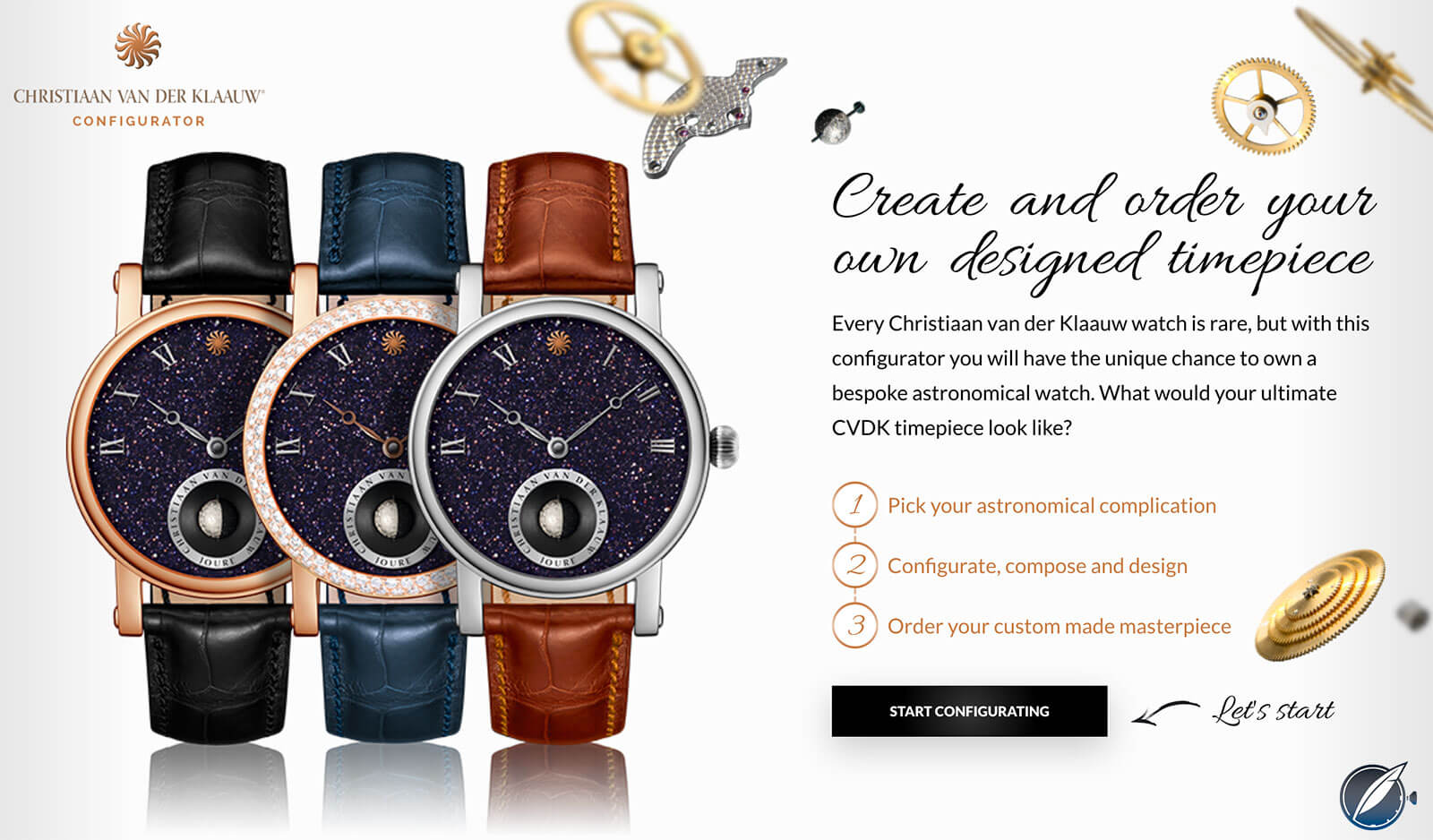
Christiaan van der Klaauw’s online configurator
Bovet uses a similar procedure to bring a customer’s design to production, beginning as a discussion of desires and goals for the project. Then Bovet submits a proposal that includes not only the customer’s design specifications but likely some of Bovet’s as well, which the customer may not have thought of.
Once there’s agreement on design details, within three days Bovet produces a computer image of what the timepiece will look like. Any changes and adjustments to the design and materials are finalized at this point.
When Bovet and the customer know just what the finished piece will look like as well as the cost, both sides approve the commission, Bovet forms the production team, and manufacturing begins.
No mention was made during our discussions as to payment timing and time to completion. Suffice it to say that we’re talking about creating a world-class work of art here. It will be expensive and will take as long as it takes.
Though, as Bovet says, most people are surprised at how fast the project proceeds because the company’s manufacturing process is so vertically integrated. Bovet controls most everything involved in the process.
Its Dimier factory in Tramelan, employing 73 people spread over 41 professions, produces all the haute horlogerie pieces. Under a single roof Bovet designs and produces the movements, dials, and cases for its regular and custom pieces.
Romain Gauthier seems to employ a slightly less formalized process; Gauthier himself is the special order department from which all custom work comes. He talks with the customer, gets the design specifications required, then costs it out. Once agreement is reached with the customer, production begins.
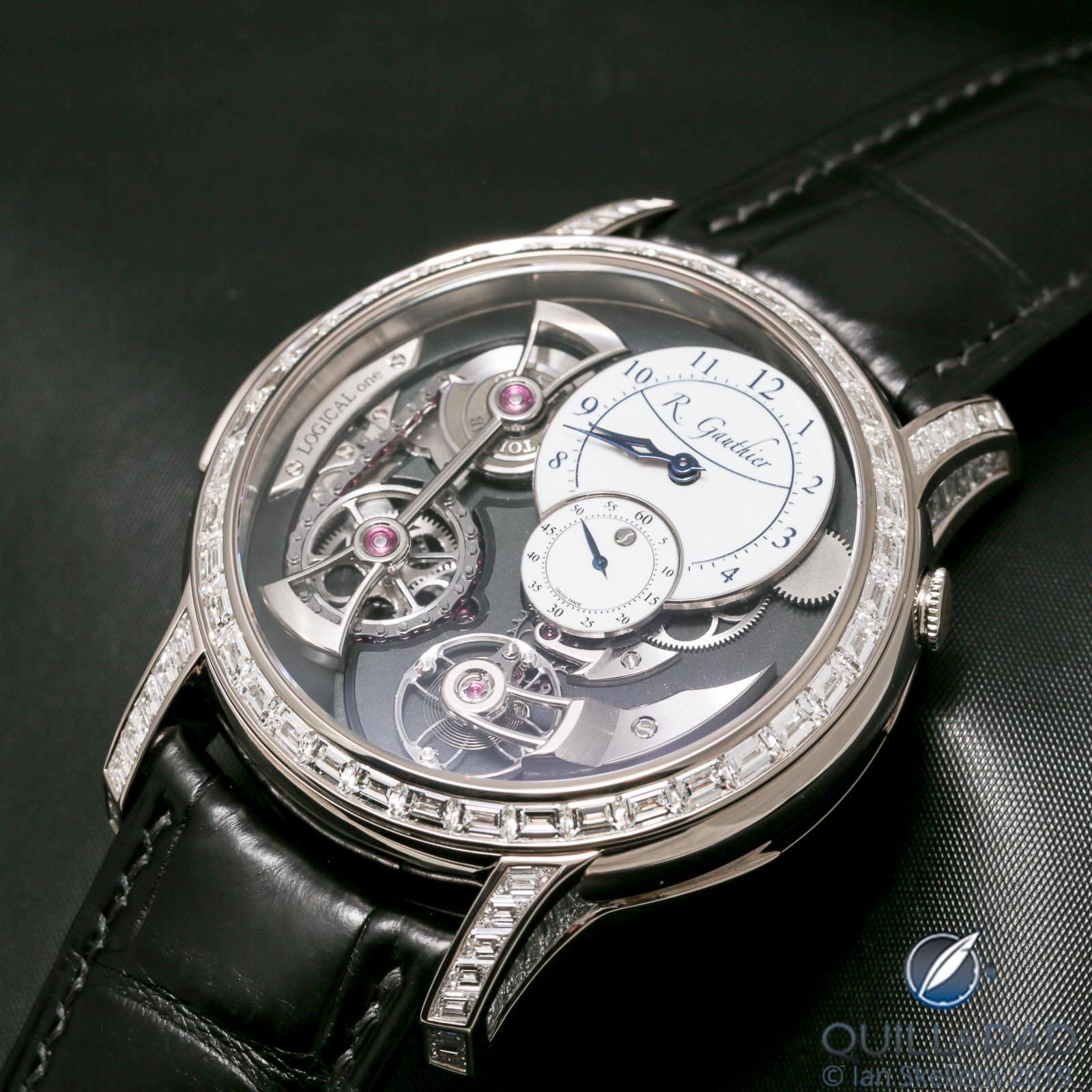
Logical One by Romain Gauthier set with baguette-cut diamonds
Final thoughts
For the last two months I’ve been researching and writing about watch customization. I’ve spoken with some of world’s top watchmakers who perform customization. Some are more adventurous than others.
At the end of this, I’ve realized several things: watches are truly among the most personal objects anyone can own. They are with us always. They exist to do much more than merely provide the time; they communicate something personal about us to others. Sometimes that communication is very subtle, intended only for those who know what to look for.
The custom pieces I’ve written about do that on a much deeper level. The cost of the piece seems irrelevant to the watchmakers. What is meaningful is that the owner took the time and effort to determine exactly what it was he or she wanted his or her watch to say. Then they sought out the artist/watchmaker who best could create the design.
These incredibly talented watchmakers are actually artists at heart. They love creating unique timepieces for customers they’ve come to know. To them, sharing their talents and creativity with someone who is equally as enthusiastic about the project is the reason they embarked on customization in the first place.
For more information, please visit:
www.arminstrom.com/en/configurator/
www.configurator.klaauw.com/
www.bovet.com/
www.romaingauthier.com/
Quick Facts Bovet Récital 22 Grand Récital
Case: 46.3 x 19.6 mm, red gold or platinum
Functions: hours (24), retrograde minutes, seconds (on tourbillon); precision moon phase, date, power reserve indication, perpetual calendar (on back) with hour, day, month, and leap year
Movement: manually wound Bovet Caliber 17DM03-TEL with one-minute flying tourbillon, variable inertia balance, nine-day power reserve
Limitation: 60 pieces across all variations, including customized pieces
Price: $469,800 (red gold), $502,200 (platinum)
Remark: five-year warranty
You may also enjoy:
Watch Customization: Give People The Watch They Want
Design Your Own Watch? A Collector Explains The Pros And Cons With Ochs Und Junior
The Astronomical Grandeur Of The Bovet Récital 22 Grand Récital
Visiting Christiaan Van Der Klaauw: To The Moon And Back!
Christ The Redeemer On A Watch: Logical One Secret Kakau Höfke By Romain Gauthier
Commissioning A Watch: My Journey With The Kari Voutilainen Masterpiece Chronograph II
Leave a Reply
Want to join the discussion?Feel free to contribute!





















































Excellent article, thanks.
Two things to note, though:
firstly, there are still too many firms that do not engage in customisation even for simple requests. I have made enquiries of more than half a dozen manufacturers whether they could furnish me a regular production watch without a date window, only to be told that this is impossible. They would not even consider it.
Secondly, customisation can be had even in the four-figure range. I own several watches by Habring and Ochs und Junior which are genuinely unique pieces in both design (case, dial, hands) and technical specs, and all but two of them came in under the magic mark.
Chris talks about Ochs und Junior more in the first customization article in his trilogy, which you can find here: Watch Customization: Give People The Watch They Want. And Habring, of course, will do almost anything a customer asks and delivers it in perfect quality and with a generous Austrian smile!